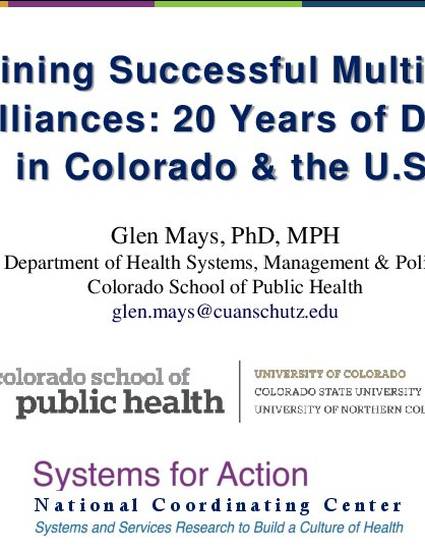
Presentation
Sustaining Successful Multi-Sector Alliances: 20 Years of Data in Colorado and the U.S.
Public Health in the Rockies Annual Meeting, Colorado Public Health Association
(2019)
Abstract
Objectives: The National Longitudinal Survey of Public Health Systems has followed a nationally representative cohort of U.S. communities since 1998 to examine the evolution of multi-organizational alliances supporting core public health functions and population health improvement activities. Research using this cohort has demonstrated that densely-connected, multi-sector alliances performing a broad scope of public health activities produce sizable health and economic gains for their communities over time. For this session we use the recently completed 2018 wave of the survey and earlier data to profile public health system dynamics and trajectories across the entire 20 year period, comparing Colorado to the rest of the U.S. Specifically, we (1) quantify changes in size, organizational composition, and scope of activity among public health multi-sector alliances over 20 years; (2) identify organizational and community characteristics that predict gains and losses in alliance strength over time; and (3) estimate the health and economic effects of alliances over a 20-year horizon.
Methods: Our survey follows 360 metropolitan communities over time using survey data collected during 1998-2018, and 300 rural communities collected during 2014-2018. Local health officials reported the availability of 20 recommended public health activities in each community, and the organizations that contributed to performing each activity in each year including public agencies, hospitals, primary care providers, insurers, employers, schools, and community-based organizations. We link survey data with secondary data on socioeconomic characteristics, health resources, area-level medical spending, mortality rates, and life expectancy. We estimate how multi-sector alliances influence community health and economic outcomes, while controlling for both observable and unmeasured confounders.
Results: Gains in alliance strength over time were attributable to expanded contributions from hospitals, FQHCs, CBOs, and insurers, and with public health agency accreditation after 2012. Losses in alliance strength were attributable to socioeconomic decline and reductions in governmental public health contributions. Among communities that sustained strong alliances, 20-year estimates of health and economic gains were 2.6 to 4.3 times larger than 10-year estimates, indicating accelerating cumulative impact.
Conclusions: The benefits of strong public health systems grow over time, especially during the second decade of development. Public health financing policies and incentives should focus on long-term system development and maintenance, modeled after public infrastructure investments.
Disciplines
Publication Date
Summer August 28, 2019
Location
Keystone, CO
Citation Information
Glen P Mays. "Sustaining Successful Multi-Sector Alliances: 20 Years of Data in Colorado and the U.S." Public Health in the Rockies Annual Meeting, Colorado Public Health Association (2019) Available at: http://works.bepress.com/glen_mays/345/
